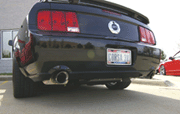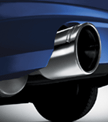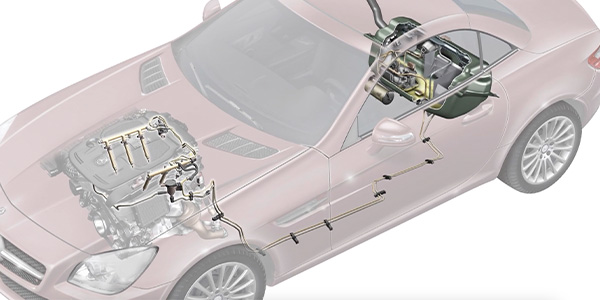What’s hot in exhaust performance products? Bolt-on free-flowing exhaust systems for diesel trucks, big bore mufflers for sport compact cars, and low restriction street performance mufflers for cars like Mustangs, Pontiac G8s, Dodge Chargers and Chevy Corvettes.
The diesel market has been really hot lately. Turbo diesel engines are a popular option in full-size Dodge, Ford and GM pickups because a diesel engine provides gobs of torque while squeezing maximum fuel economy out of each drop of fuel. What’s more, many diesel-powered pickup trucks are used for towing trailers, not just commuting or getting groceries, so any upgrade that adds horsepower is a plus.
The aftermarket has really stepped up to the plate in developing new performance products for diesel trucks. There’s been a proliferation of diesel “tuner” scan tools that allow a user to dial-in more power by turning up the turbo boost pressure and tweaking the fuel mixture and other settings. Also available are a number of bolt-on exhaust performance packages specifically designed for popular truck models. These package systems that typically replace the stock exhaust system from the converter back reduce backpressure and really help the turbo breathe.
The diesel performance market has been stimulated by a growing interest in diesel racing. Truck pulling events have been around for years, and some say interest in this particular sport has been waning. What’s new is the appearance of more diesel-powered vehicles in events where diesels have been a rarity: drag racing, road racing and even at the Bonneville Salt Flats.
 A diesel-powered Audi race car recently won the Le Mans 24 hour endurance race in France. A new land speed record of 328 mph for diesel power was set by the JCB Dieselmax streamliner at Bonneville a little over a year ago. A group called the Diesel Hot Rod Association (www.dhraonline.com) has been promoting diesel drag racing at various tracks around the country. Many of the diesel-powered Pro Street trucks at these events are running in the 9-second range at speeds in excess of 140 mph in the quarter mile. The fastest diesel pickup truck is currently a twin turbocharged 6.6L Duramax-powered Chevy S10 built by Gale Banks. Last October, the S10 set the record by covering the quarter mile in 8.21 seconds at 165 mph. We’re also seeing more diesel-powered rail dragsters with modified Cummins or Duramax engines.
A diesel-powered Audi race car recently won the Le Mans 24 hour endurance race in France. A new land speed record of 328 mph for diesel power was set by the JCB Dieselmax streamliner at Bonneville a little over a year ago. A group called the Diesel Hot Rod Association (www.dhraonline.com) has been promoting diesel drag racing at various tracks around the country. Many of the diesel-powered Pro Street trucks at these events are running in the 9-second range at speeds in excess of 140 mph in the quarter mile. The fastest diesel pickup truck is currently a twin turbocharged 6.6L Duramax-powered Chevy S10 built by Gale Banks. Last October, the S10 set the record by covering the quarter mile in 8.21 seconds at 165 mph. We’re also seeing more diesel-powered rail dragsters with modified Cummins or Duramax engines.
The point is there’s a lot of interest lately in making diesels go fast, which translates into more interest in diesel street performance products such as bolt-on exhaust systems. The advantage with installing a complete bolt-on system is that all the fitting work has already been done for you. You don’t have to use a tube bender to fabricate a whole new system from scratch. Better yet, most of these systems are made of corrosion-resistant stainless steel rather than plain steel. That mean’s your customer’s investment in a new aftermarket exhaust system should provide years of trouble-free performance.
DOMESTIC MUSCLE CAR OPPORTUNITIES
The late-model performance car market has been dominated in recent years by the Ford Mustang. Ford hit a home run when it introduced the “new” Mustang in 2005, which was essentially a modern redo of the classic styling from the 1965-68 Mustang. It seemed like every other booth at that year’s SEMA Show in Las Vegas featured a tricked-out Mustang.
Dodge has also captured a segment of this market with their aggressive-looking Charger. The resurrection of the legendary Hemi engine has also added to the mystique, and allowed Chrysler to offer a number of performance models including the Dodge Magnum, Chrysler 300 Hemi and Charger Hemi. Dodge will also be offering their redo of their classic Challenger this year, too, giving Mustang some much needed competition. Chevrolet has always had their Corvette, but the demographic for this car now tends to be a 50-something white male who can finally afford the Corvette he always wanted when he was younger. Chevy will also be jumping back into the street performance market with their classic Camaro redo this year, which should further bolster demand for hot new exhaust products for these kind of vehicles.
Though imports have stolen much of the new car market away from the domestic vehicle manufacturers, most of these sales have been for high end luxury cars and SUVs. Applications for aftermarket performance exhaust products has been mostly limited to the sport compact segment, and most of these are older Honda Civic and Accord models, Mitsubishi Eclipse, and similar models that are in the hands of the second or third owners. The soaring price of gasoline is also a factor to consider in today’s market. When it takes more money to fill the tank, there’s less money left for discretionary spending. Food, rent and utility bills usually take priority over everything else, so there’s less free cash floating around in the economy these days for buying aftermarket exhaust goodies. Even so, people are still spending money on performance mufflers and exhaust systems. Why? Because they want them. And they can often justify it by gaining a little extra fuel economy thanks to less exhaust system backpressure.
IT’S NOT JUST PERFORMANCE
Another very important selling point to keep in mind about performance exhaust products is that not just power, it’s also sound, appearance and image.
High performance mufflers and exhaust systems are as much about looks and sound as they are horsepower. Most customers who want these kinds of products want mufflers and exhaust systems that look and sound as good as they perform. It’s all about personalizing their vehicle and projecting an image. Customers who buy performance exhaust products are the same ones who buy aftermarket custom wheels, street performance tires, performance shocks, struts and suspension kits, aftermarket sound systems, spoilers, wings, aero kits and other bolt-on accessories.
Unlike your typical exhaust customer who gripes about every nickel he or she has to spend on replacing a blown-out muffler or pipe, these people actually enjoy spending money to accessorize, customize and improve their vehicles. It’s a priority for them, and they spend accordingly. Consequently, you don’t have to haggle price with them. They will often pay two, three or even four times as much for a high end performance exhaust system as what it would cost to replace the stock muffler and pipes on their vehicle.
There’s a real opportunity for shops who pursue this kind of customer because (1) it’s more profitable than everyday repair work, and (2) you don’t have to wait for parts to fail to make a sale. Performance exhaust customers will often buy a brand new car or truck and have the stock mufflers and pipes replaced because that’s what they want.
STAINLESS & COATED STEEL
Most premium quality performance mufflers and pipes today are made of stainless steel (usually aircraft-quality T-304), but there are lesser quality grades of stainless that sell for less. A stainless performance muffler can retail for $200 to $300 or more, and a complete system can easily cost $500 to $800 or more plus installation depending on the make and model of the vehicle.
Ceramic coatings are another option. Various aftermarket companies can apply a wide range of ceramic-metallic coatings to exhaust pipes and headers. These coatings won’t flake off and retain their like-new appearance for years. Not only does this extend the life of the exhaust system, but it also keeps the heat in the exhaust. That means lower temperatures under the hood and under the car, and higher exhaust velocity through the system for better scavenging, breathing and more power.
Most performance pipes are formed with mandrel bends which do not narrow the diameter of the pipe where it curves. This reduces unwanted restrictions and keeps the exhaust flowing freely. Pipes may also be larger in diameter to reduce backpressure and increase flow.
Most premium mufflers and systems are also plasma or TIG welded to maintain the strength and corrosion resistance of the stainless steel. Some manufacturers also use a process called “bulge forming” or “hydroforming” to form steel sheets into molded shapes using extremely high fluid pressure.
WHAT KIND OF MUFFLER?
Performance mufflers typically have a straight-through perforated tube wrapped with fiberglass, ceramic or stainless steel packing material to absorb sound. Or, they use a “turbo” design that routes the exhaust in a loop or S-shaped path to reduce noise. Others feature a unique arrangement of baffles and plates within the muffler shell, or use a hybrid design that combines sound-absorbing packing with a classic turbo flow pattern.
 Performance mufflers are available in both direct-fit or universal configurations. You’ll find the greatest selection in universal mufflers, which can be adapted and made to custom fit almost any application. Installation may require some cutting and welding, as well as fabricating custom hangars. But such tasks add labor cost and boost the profitability of the job.
Performance mufflers are available in both direct-fit or universal configurations. You’ll find the greatest selection in universal mufflers, which can be adapted and made to custom fit almost any application. Installation may require some cutting and welding, as well as fabricating custom hangars. But such tasks add labor cost and boost the profitability of the job.
Direct-fit performance mufflers and complete exhaust systems are designed to replace the stock muffler and pipes perfectly. They are easy to install and require no modifications, but may only be available for the more popular applications.
 Sound quality is harder to control with a universal fit muffler. The right"ame muffler that sounds great on one vehicle may not sound as good on another because of different exhaust frequencies produced by the engine. That’s why a muffler or complete system designed for a specific application usually delivers the best sound.
Sound quality is harder to control with a universal fit muffler. The right"ame muffler that sounds great on one vehicle may not sound as good on another because of different exhaust frequencies produced by the engine. That’s why a muffler or complete system designed for a specific application usually delivers the best sound.
COMPLETE SYSTEMS
Cat-back exhaust systems are the best way to go for street applications. Don’t even think about removing the converter and replacing it with a straight pipe because it’s illegal. If a vehicle came factory-equipped with a converter, it has to have a converter to be street-legal. Off-road, anything goes. How much power can be gained by installing a performance muffler or complete exhaust system? It depends on the OEM exhaust system it replaces. The more restrictive the stock system is, the more power an aftermarket free-flowing exhaust system will make.
Most manufacturers claim power gains of 15 to 25 horsepower or more with their products. The larger the displacement of the engine, the more it usually benefits from upgrading to a free-flowing exhaust system. This is especially true with big turbocharged diesel engines. Reducing exhaust backpressure allows boost to come up more quickly and to reach a higher level throttle response is also improved, and the engine usually runs cooler.
HEADERS
Exhaust headers have long been available for many older vehicles, but are also available for many sport compact cars and modern day muscle cars such as Mustang, Corvette and others. The free-flowing four-into-one or four-into-two-into-one welded tube headers are more efficient at routing exhaust out of the engine than most stock manifolds, and provide a boost in both power and torque for a couple hundred bucks.
Stainless steel headers are the most durable, but are also the most expensive. The best ones are ceramic coated for durability and appearance, but the coating can add $100 to $200 to the price tag.
Installing exhaust headers may be easy or difficult depending on accessibility and the age of the vehicle. Just make sure the headers have the required fittings for the oxygen sensor or other emission hookups that are required to be street legal.
Additional power gains and sound improvements can be obtained by adding a “H” or “X” crossover pipe downstream of the engine on applications with dual exhausts. The crossover pipe allows pulses from one side of the engine to interact with those on the other side. This improves scavenging and can add an additional five to 20 horsepower depending on the application.












